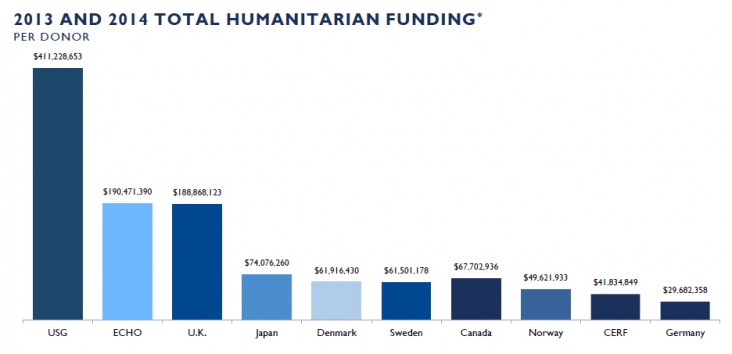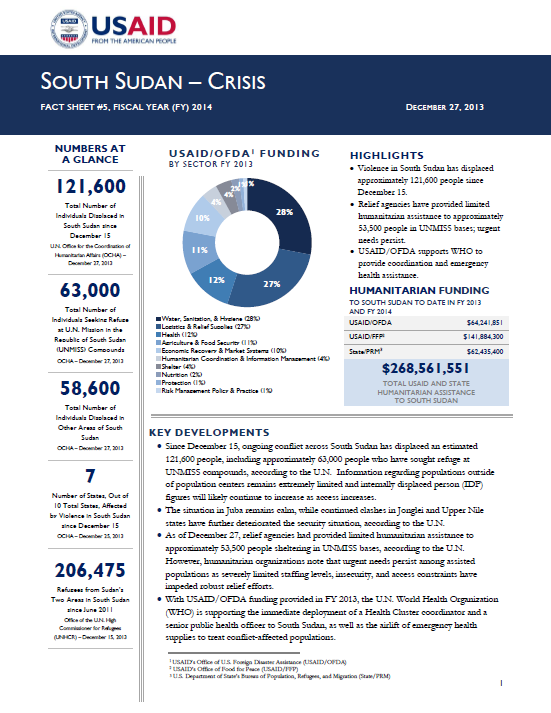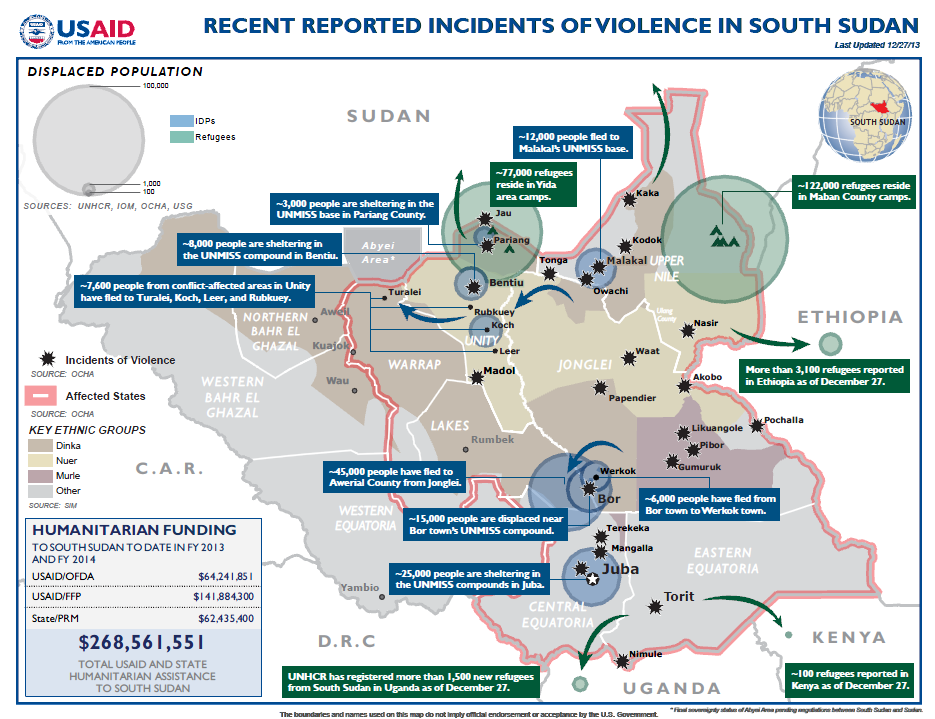- What We Do
- Agriculture and Food Security
- Democracy, Human Rights and Governance
- Economic Growth and Trade
- Education
- Environment and Global Climate Change
- Gender Equality and Women's Empowerment
- Global Health
- Humanitarian Assistance
- Transformation at USAID
- Water and Sanitation
- Working in Crises and Conflict
- U.S. Global Development Lab
Speeches Shim
May 9, 2014
Numbers At A Glance
959,000
79,400
879,600
331,300
237,700
Humanitarian Funding:
To South Sudan To Date In FY2014:
| USAID/OFDA | $60,775,086 |
| USAID/FFP | $35,000,000 |
| State/PRMDoD | $47,300,000 |
| TOTAL | $143,075,086 |
Highlights
Nearly 7 million of the 11.1 million people in South Sudan are acutely food insecure.
Clashes in Jonglei, Unity, and Upper Nile states continue to impede access.
UNMISS human rights report states that both the Government of the Republic of South Sudan (RSS) and opposition elements are responsible for violations.
KEY DEVELOPMENTS
U.N. Secretary-General (SYG) Ban Ki-moon visited South Sudan on May 6 to observe the U.N.’s political and humanitarian responses and to pressure RSS and opposition leaders to find a political solution to the conflict. In addition to meeting with President Salva Kiir and U.N. officials, SYG Ban visited the Tong Ping UNMISS civilian protection site in Juba town, Central Equatoria State, and met with internally displaced person (IDP) community leaders.
In a report released on May 8, UNMISS states that all parties to the conflict have committed violations of international human rights and humanitarian law, including extrajudicial killings, enforced disappearances, rape, arbitrary arrests, and attacks on U.N. peacekeeping staff. The report, which compiled results from more than 900 victim and witness testimonies, details violations that occurred in Central Equatoria, Jonglei, Unity, and Upper Nile. According to the report, RSS and opposition forces engaged in widespread, systematic—and in some cases planned and deliberate—attacks against the civilian population of South Sudan.
On May 5, RSS and opposition representatives signed a recommitment to the articles of the January 23 cessation of hostilities agreement relating to humanitarian issues, including facilitating access to all affected populations through opening humanitarian corridors. The parties also agreed to “consider one month of tranquility” through June 7 to allow humanitarian actors to pre-position food and other relief commodities and to permit civilians to engage in planting activities, although fighting has continued since that recommitment.
INSECURITY, DISPLACEMENT, AND ACCESS CONSTRAINTS
Security conditions remain fluid in South Sudan, with Sudan People’s Liberation Army (SPLA) and opposition forces continuing to clash in areas of Jonglei, Unity, and Upper Nile. The current conflict has displaced nearly 1.3 million people—including 959,000 IDPs and 331,300 people who are seeking refuge in neighboring countries—since December 15.
Tensions remain high in Bentiu and Rubkona towns, Unity, following clashes in early May. Fighting also continues in northern Unity’s Abiemnhom, Mayom, and Pariang counties, resulting in additional population displacement.
As violence in Unity persists, displacement to neighboring Abyei Area is increasing, according to the U.N. More than 3,000 displaced persons from Unity arrived in Abyei during the last two weeks of April, adding to an estimated 3,000 displaced persons who had already fled South Sudan to Abyei earlier in 2014. The influx is straining limited basic resources, such as access to safe drinking water, and is stretching the capacity of host communities to absorb new arrivals, according to relief agencies.
The U.N. also reports ongoing clashes in Jonglei’s Duk and Twic East counties. The recent fighting, in addition to ongoing tensions in Bor town, Jonglei, following the April 17 attack on the UNMISS compound, has prompted additional populations to flee toward Mingkaman town, Awerial County, Lakes State.
Conflict in and around Nasir town, Upper Nile, in early May prompted at least 11,000 people—mostly women and children—to flee to Ethiopia between May 4 and 6, according to UNHCR. International media report that SPLA forces had gained control of Nasir as of May 4; however, the situation remains volatile, and South Sudanese refugees continue to flee clashes toward Ethiopia. In response, UNHCR, Ethiopia’s Administration for Refugee and Returnee Affairs, and the Ethiopian Red Cross Society are scaling up response efforts to meet the increased humanitarian needs.
South Sudan Crisis Fact Sheet #41 May 9, 2014 ![]() (pdf - 261k)
(pdf - 261k)
South Sudan Crisis Map May 9, 2014 ![]() (pdf - 937k)
(pdf - 937k)
HUMANITARIAN NEEDS ASSESSMENTS AND RESPONSE ACTIVITIES
The U.N. Rapid Response Mechanism (RRM)—led by the U.N. Children’s Fund (UNICEF), the U.N. Food and Agriculture Organization (FAO), and the U.N. World Food Program (WFP)—continues to provide humanitarian assistance, including food commodities and health care, to vulnerable populations in remote locations. Despite progress, insecurity and weather-related challenges continue to hinder humanitarian access. Poor weather conditions in the beginning of May, for example, impeded access to the airstrip in Lankien town, Jonglei, forcing RRM partners to reschedule planned relief activities to a later date.
CAMP COORDINATION AND CAMP MANAGEMENT
The Camp Coordination and Camp Management Cluster (CCCM)—the coordinating body for humanitarian CCCM activities, comprising U.N. agencies, non-governmental organizations, and other stakeholders—continues efforts to improve and expand existing civilian protection areas at UNMISS bases across South Sudan. The CCCM Cluster also continues to erect humanitarian hubs to facilitate relief work in remote locations. As of May 5, CCCM Cluster partners had set up five hub tents—with the capacity to accommodate 50 aid workers—at the Malakal civilian protection area in Upper Nile, according to the International Organization for Migration (IOM).
AGRICULTURE, FOOD SECURITY, AND NUTRITION
An IPC alert released on May 9 following the South Sudan IPC analysis workshop reports that 6.9 million people in South Sudan are currently acutely food insecure, with an estimated 3.7 million people experiencing Crisis—IPC 3—and Emergency—IPC 4—levels of food insecurity.[1] The alert warns that the number of people experiencing Crisis and Emergency levels of food insecurity is likely to rise to as many as 7.3 million between June and August and notes that pockets of populations within some counties may face the risk of famine without adequate humanitarian assistance. The majority of those facing food insecurity are conflict-affected IDPs and host communities in Jonglei, Unity, and Upper Nile, where between 50 and 85 percent of people are experiencing Crisis or Emergency levels of food insecurity.
Despite ongoing insecurity, WFP and implementing partners continue to reach populations in need. During the first week of May, WFP and partners distributed nearly 490 metric tons (MT) of assorted food commodities to more than 32,200 beneficiaries—including IDPs in Bor County and food insecure populations in Pibor and Pochalla counties—in Jonglei. In April, WFP and partners provided food assistance to more than 397,000 people across South Sudan, including approximately 240,400 people in Jonglei, Unity, and Upper Nile.
Between April 29 and May 5, UNICEF supported the International Medical Corps to screen nearly 1,000 children under five years of age in the Malakal civilian protection area for malnutrition. Approximately 3 percent of those screened exhibited severe acute malnutrition, while nearly 14 percent exhibited moderate acute malnutrition.
HEALTH AND WASH
Relief actors remain particularly concerned regarding health and water, sanitation, and hygiene (WASH) conditions at the Malakal UNMISS civilian protection area following a week of heavy rains in early May. According to the U.N., the rains resulted in flooding, inundating the shelters of approximately 40 percent of the IDP population. Flooding, combined with the impact of congestion on health and WASH conditions increased concerns regarding illnesses, such as acute watery diarrhea, acute respiratory tract infections, and malaria. In response, relief actors continue to monitor health trends and recently completed a second round of oral cholera vaccinations at the civilian protection site, reaching nearly 2,200 people.
USAID/OFDA partner World Vision is improving WASH conditions by constructing additional latrines at the civilian protection area. In addition, IOM recently completed drainage works to reduce the presence of stagnant water.
Health actors reacted swiftly after one individual at the U.N. House UNMISS site in Juba tested positive for cholera on April 29. As the April-to-August rainy season continues to intensify, relief actors are scaling up efforts to prevent cholera outbreaks. As of May 7, health actors had vaccinated more than 74,100 children against cholera since December 15.
Despite ongoing insecurity in Bentiu, UNICEF and partners continue to scale up WASH support to more than 22,500 IDPs in the UNMISS civilian protection area. UNICEF recently completed the construction of a second borehole and is working on drilling a third, increasing access to safe drinking water, with IDPs receiving approximately 9 liters of safe water per person per day. In addition, WASH partners distributed water treatment supplies to approximately 5,000 households at the site.
LOGISTICS AND RELIEF COMMODITIES
During the first week of May, on behalf of 13 relief organizations, the Logistics Cluster facilitated the airlift of 72 MT of humanitarian commodities to populations in Unity’s Bentiu, Ganyiel, Mayendit, and Nytal towns; Jonglei’s Akobo and Pochalla towns; and Malakal town.
Storage capacity across South Sudan remains limited, according to WFP. Logistics Cluster partners are currently coordinating to identify areas where organizations can expand common warehousing facilities. Meanwhile, to facilitate the delivery of relief items to the IDPs sheltering at the UNMISS base in Bentiu, the Logistics Cluster plans to dispatch one additional repositionable storage unit to the area to increase storage capacity.
PROTECTION
Since conflict erupted on December 15, RSS and opposition elements have recruited an estimated 9,000 children into armed groups, according to UNICEF. The estimate is based on observations of children wearing military uniforms and carrying weapons, children undergoing military training, and children seen with armed groups.
Despite ongoing tensions, UNICEF and other child protection agencies continue to respond to increased child protection needs in Bentiu and Bor. Between April 29 and May 5, partners identified approximately 280 unaccompanied and separated children in the two towns, bringing the total number of children identified in South Sudan to approximately 3,780. Relief agencies are working to provide psychosocial support to unaccompanied and separated children and continue to construct child-friendly spaces in affected areas.
OTHER HUMANITARIAN ASSISTANCE
To date, international donors have provided nearly $526 million—more than 41 percent of the $1.27 billion total requested funding—to support humanitarian activities through the South Sudan Crisis Response Plan. Of the $744 million shortfall in funding, humanitarian partners have reported that a minimum of $232 million is necessary to maintain current service levels and prevent a severe deterioration of humanitarian conditions in the next three months, according to the U.N.
Humanitarian actors continue to work on a revised Crisis Response Plan (CRP), which will build on the current January-to-June CRP, to address humanitarian needs for the remainder of 2014. The new CRP will reflect the humanitarian consequences of the crisis, demonstrate the response results and impact to date, and detail the resource requirements necessary to enable partners to provide basic services to affected populations.
The European Commission’s Directorate-General for Humanitarian Aid and Civil Protection (ECHO) announced on May 7 an additional €4.5 million—approximately $6.3 million—in support to UNICEF in an effort to scale up emergency response efforts in South Sudan. The additional funding will help UNICEF increase access to safe drinking water, distribute sanitation-related relief commodities, conduct measles vaccination campaigns, provide therapeutic nutritional supplements to malnourished children, create child-friendly spaces, offer psychosocial support, and strengthen relief agency coordination.
OTHER HUMANITARIAN ASSISTANCE
To date, international donors have provided approximately $497 million—more than 39 percent of the $1.27 billion total requested funding—to support humanitarian activities through the South Sudan Crisis Response Plan. Of the $773 million shortfall in funding, humanitarian partners have reported that a minimum of $232 million is necessary to maintain current service levels and prevent a severe deterioration of humanitarian conditions in the next three months, according to the U.N.

*Funding figures are as of April 25, 2014. All international figures are according to OCHA’s Financial Tracking Service (FTS) and based on international commitments during the 2013 and 2014 calendar years. USG figures are according to the USG and reflect the most recent USG commitments based on the 2013 fiscal year, which began on October 1, 2012, and ended September 30, 2013, as well as the 2014 fiscal year, which began on October 1, 2013.



Comment
Make a general inquiry or suggest an improvement.